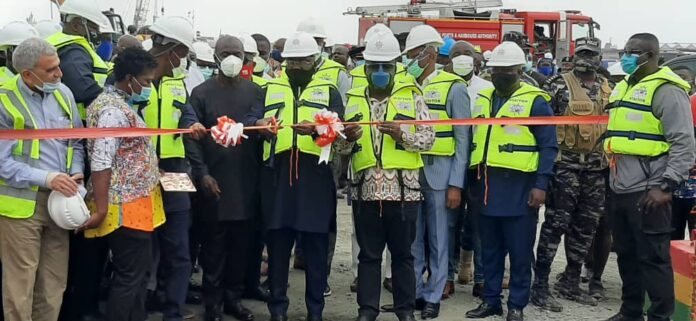
The Vice President, Alhaji Mahamadu Bawumia, has inaugurated the state of art New Liquid Bulk Terminal at Takoradi Port.
The Vice President also cut the sod for the construction of a new multi-purpose Dry Bulk Jetty Phase Two, also at the Takoradi Port.
The newly inaugurated Liquid Bulk Terminal, the biggest in West Africa, has five loading arms for five products, namely: petrol, diesel, LPG, heavy fuel and bitumen.
The three-phase project being undertaken by Ibistek Ghana with funding from the Ghana Infrastructure and Investment Fund (GIIF) cost US$56.7million, and is expected to make Ghana the leading cargo destination in the West African sub-region.
According to the Vice President: “This project ties in with government’s drive toward ensuring efficiency in the country’s port operations by allowing for deeper anchoring and also to make it a major petroleum hub in the sub-region”.
He commended Ibistek Ghana, a developer and operator of the Takoradi Port, for delivering beyond expectation.
He said Ibistek, a wholly Ghanaian-owned entity, has reiterated the need to continue believing in the private sector.
Peter Mac Manu, Chairman of the Board of Directors of the Ghana Ports and Harbours Authority said: “The Port of Takoradi, as you may have seen already, has been undergoing major transformation since GPHA kick-started an Infrastructure Upgrade and Expansion Programme for the Port in 2011”.
He said the port has sustained the commitment to enhance and fast-track port infrastructure projects as part of the National Development and Poverty Alleviation agenda.
He said with completion of the New Terminal, more than 50% of Ghana’s domestic petroleum consumption demands can be met with ease.
He explained that the Liquid Bulk Terminal consists of a 14m-water depth berth – the deepest in-harbour berth in Ghana at the moment ‘deeper than that of Tema oil Berth’); loading arms for five petroleum products (petrol, diesel, LPG-gas, bitumen, and other heavy fuels); full berthing structures including fenders for dolphins, bollards and hooking points.
The berth facility, he said, is designed to support vessels up to 60,000 tonnes for petroleum cargo carriers. “We will need two or three of the current tank farm customers to share one such cargo volume.
“As Chairman of the GPHA Board, working in consonance with the Management and staff we have sustained the commitment to enhance and fast-track these port infrastructure projects as part of our National Development and Poverty Alleviation agenda,” he said.
He pointed out that that the certification processes for safe transfer of fuels through the pipes are almost complete.
“By way of direct jobs, the terminal is expected to employ about 100 in-port specialist personnel and more than 500 indirect jobs to operate the facility; It is an 810-metre long wharf facility for three large ore carriers, which will be served by loaders (or unloaders) and conveyor systems.
“The dry bulk terminal is where we intend to handle increased volumes of bauxite, manganese and all the cement-related cargos – such as clinker, gypsum, limestone, lime, furnace slag; and then other new bulk cargoes that may evolve within the market space,” he further explained.
Mr. Manu said the terminal is designed to handle nearly 18.5 million-metric tonnes of cargo per annum. Currently, the dry bulk cluster is hovering around 6.5 million metric tonnes per-annum.
On the sod-cutting for Phase-two of the New Bulk Jetty Project, he explained: “This latter part of superstructure work is being carried out by Amandi Investments Limited, at a cost of US$70million”.
He said a complete set of conveyor systems will be installed to all three berths – including one loading arm for the export berth, full terminal pavement, utilities services, water, electricity, terminal operations control office among others – to ensure seamless operations for all the current cargo owners and be resilient enough to add on new cargo owners and volumes.
Work, he said, is expected to be completed by second-quarter of 2022; and terminal operations will employ not less than 150 persons on direct terminal roles, and give not less than another 1,000 indirect employment opportunities.
Kwabena Okyere Darko-Mensah, Western Region Minister, commended government for its special interest in the region.
“Western Region has benefitted from a number of good projects; such as coastal protection and development, roads, railways, among others which are very commendable,” he said.
With all these project, he said, the region is assured a booming economy.
Kwaku Ofori Asiamah, Minister of Transport, commended Ibistek for the bold step in executing all these project.
Lawyer Kwame Gyan, Chairman of Ibistek said: “Ibistek over the past few years has invested US$322.7m in the Takoradi Port alone to make the facility able to provide capacity for future growth in investment”.
Dry Bulk Jetty
The Dry Bulk Jetty project, when completed, will help in the efficient handling of dry bulk cargos like manganese, bauxite, clinker, gypsum, quick lime, etc at the Takoradi Port.
The existing facility for handling such cargos is 120 metres with a depth of 8.6 meters and the new one which was commissioned by the Vice President is 300 meters with a depth of 14 metres









